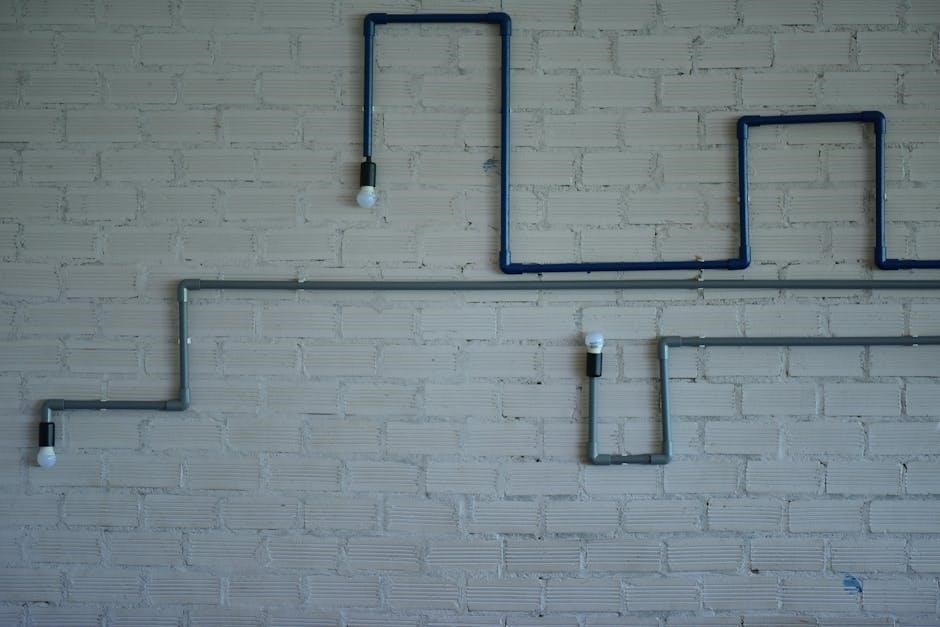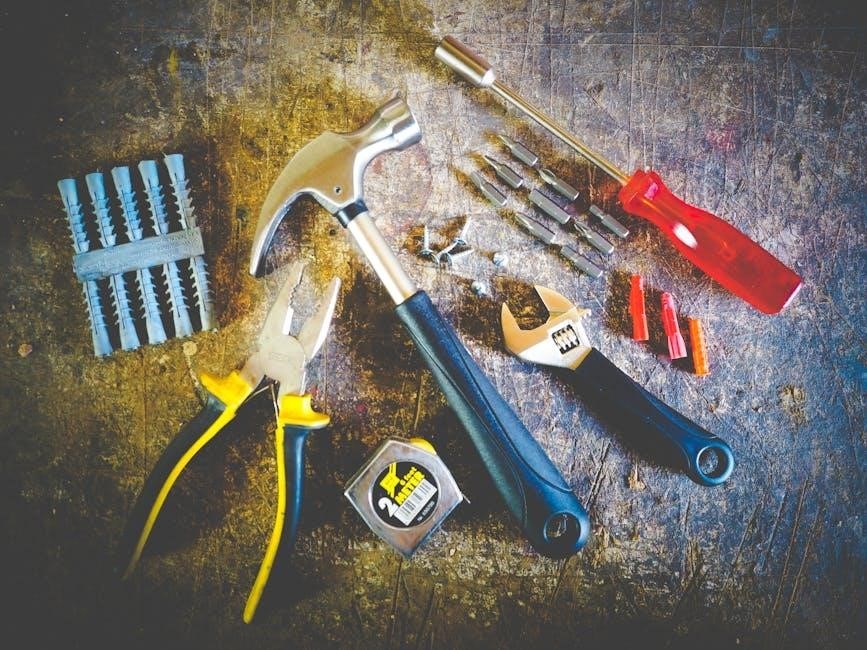DSI installation involves proper setup of products like columns, railings, and turnstiles, ensuring safety and efficiency. This guide provides a comprehensive overview to help users install DSI products correctly.
1.1 Overview of DSI Products
DSI offers a range of products, including columns, railings, and turnstiles, designed for durability and functionality. Their square columns are load-bearing, while vinyl railings provide aesthetic appeal. Optical turnstiles are high-tech yet straightforward to install. These products cater to various settings, ensuring safety and efficiency. DSI solutions are engineered for both residential and commercial applications, emphasizing robust construction and ease of integration with existing systems.
1.2 Importance of Proper Installation
Proper installation of DSI products is crucial for safety, functionality, and durability. Incorrect setup can lead to structural issues or system malfunctions. Following installation instructions ensures load-bearing capacity is maintained, especially for columns and turnstiles. It also guarantees compliance with safety standards, preventing potential hazards. Proper installation optimizes performance, extends product lifespan, and reduces maintenance needs, ensuring reliable operation in various environments. Adhering to guidelines is essential for achieving intended functionality and safety.
1.3 Safety Precautions
Proper safety measures are essential during DSI installation to avoid accidents. Ensure the area is clear of obstacles and wear protective gear like gloves and safety glasses. Handle electrical components carefully to prevent damage or shock. Follow all manufacturer guidelines to avoid improper installation, which could lead to system malfunctions or safety hazards. Use appropriate tools and ensure stability of heavy components to prevent injuries. Always refer to the manual for specific safety instructions tailored to your DSI product.

System Requirements and Compatibility
Ensure your system meets DSI product specifications for hardware, software, and operating systems to guarantee smooth installation and operation. Compatibility checks are crucial for optimal performance.
2.1 Hardware Requirements
DSI products require compatible hardware to ensure proper installation and functionality. Load-bearing columns need sturdy bases, while railings demand secure mounting brackets. For turnstiles, stable frames and motors are essential. Ensure all components are compatible with existing systems and meet weight and structural specifications. Proper hardware installation guarantees safety and durability, preventing potential failures. Always refer to manufacturer guidelines for specific hardware needs, as incorrect installations can lead to system malfunctions. Verify compatibility with your system’s architecture before proceeding. Adherence to these requirements ensures optimal performance and longevity of DSI installations.
2.2 Software Compatibility
Ensure your system meets the software requirements for DSI products. Compatibility varies by product, with some requiring specific operating systems or firmware versions. For instance, DSI columns and railings may need dedicated drivers, while turnstiles require compatible access control software. Verify that your system supports the latest firmware updates to maintain functionality. Network configurations should align with DSI software protocols for seamless integration. Always check the manufacturer’s compatibility list to avoid software conflicts. Proper software alignment ensures smooth operation and optimal performance of DSI installations, minimizing potential issues during setup and use.
2.3 Operating System Support
DSI products are compatible with various operating systems, including Windows and Linux. Ensure your system runs on a supported OS version for seamless integration. For example, Windows 10/11 and Linux distributions like Ubuntu are commonly supported. Some DSI systems may require specific firmware versions for optimal performance. Always verify OS compatibility before installation to avoid conflicts. Updating your operating system to the latest version is recommended for enhanced functionality and security. Proper OS support ensures smooth operation and integrates DSI products efficiently into your existing infrastructure.

Tools and Materials Needed
Essential tools include drills, screwdrivers, and wrenches. Required materials are screws, bolts, and adhesives. Optional accessories may include protective gear and additional hardware for specific setups.
3.1 Essential Tools
Essential tools for DSI installation include drills, screwdrivers, wrenches, and Allen keys. Drills are needed for creating pilot holes, while screwdrivers and wrenches secure components. Measuring tools ensure accurate alignment. Safety gear like gloves and goggles is recommended to prevent injuries. Proper tools guarantee a secure and efficient installation process, minimizing errors and ensuring durability. Always refer to the manual for specific tool requirements based on the product being installed.
3.2 Required Materials
Fasteners: Includes screws, bolts, and nuts specific to DSI products. Brackets: Essential for securing columns or railings. Adhesive materials: For bonding components where necessary. Sealants: To prevent water ingress and ensure durability. Miscellaneous hardware: Such as washers and spacers. These materials are crucial for ensuring stability, safety, and proper alignment during installation. Always use materials recommended by the manufacturer to maintain product integrity and warranty validity. Proper material selection guarantees a reliable and long-lasting installation.
3.3 Optional Accessories
Optional accessories like decorative caps for columns, lighting kits for railings, and additional security features for turnstiles can enhance functionality and aesthetics. These extras allow customization to meet specific needs or preferences. For example, lighting can improve visibility, while decorative caps add a polished look. Ensure all accessories are compatible with DSI products and follow installation guidelines. These optional items can elevate the installation’s overall performance and appearance, offering flexibility for unique setups or enhanced security measures. Always consult the manufacturer’s guidelines for proper use and compatibility.

Pre-Installation Steps
Pre-installation steps involve site preparation, unpacking, and inventory. Reading the manual ensures understanding of product specifications and safety guidelines. Proper planning is essential for a smooth installation process.
4.1 Site Preparation
Site preparation is crucial for a successful DSI installation. Ensure the area is clean, stable, and dry. Clear any debris or obstructions. Verify all measurements and alignments. Check the surface level and make necessary adjustments. Ensure proper lighting and accessibility. Confirm the site matches the product specifications. Follow DSI guidelines for specific product requirements. Proper site preparation prevents installation delays and ensures safety. Adhere to all safety protocols and manufacturer instructions for optimal results. A well-prepared site ensures a smooth and efficient installation process.
4.2 Unpacking and Inventory
After delivery, carefully unpack all DSI components, ensuring no damage during transit. Conduct a thorough inventory to verify all parts are included, as indicated in the installation manual; Cross-reference each item with the packing list to ensure completeness. Handle components with care to avoid damage. Organize parts systematically for easy access during installation. Address any discrepancies or missing items immediately with DSI support. A complete and undamaged inventory is essential for a successful installation, minimizing delays and ensuring all necessary components are readily available.
4.3 Reading the Manual
Reading the DSI installation manual is crucial before starting the project. The manual provides detailed step-by-step instructions, safety guidelines, and troubleshooting tips. It outlines compatibility requirements, hardware specifications, and essential tools needed. Familiarize yourself with load-bearing capacities, material specifications, and maintenance recommendations. Understanding the manual ensures compliance with manufacturer standards, reducing errors and potential damage. Pay attention to diagrams and illustrations for clarity. Refer to the troubleshooting section for common issues and solutions. A thorough understanding of the manual is key to a smooth and successful installation process.

Installation Process
Mount the base securely, align the column precisely, and tighten all connections. Connect internal components carefully, ensuring proper alignment and stability for optimal performance and safety.
5.1 Mounting the Base
Mounting the base is the first critical step in the installation process. Ensure the surface is level and clean. Locate the pre-drilled holes on the base and align them with the anchor points. Insert the screws through the base and tighten them firmly into the surface. Repeat this process for both the top and bottom of the column to ensure stability. Proper alignment and secure fastening are essential for a safe and durable installation. Always follow the manufacturer’s instructions for specific screw types and torque settings. This step sets the foundation for the entire installation, so precision is key.
5.2 Aligning the Column
After mounting the base, carefully lift the column and place it onto the anchored base. Ensure the column is plumb using a spirit level. Check alignment with the pre-drilled holes on the base. If necessary, use shims to adjust for uneven surfaces. Once properly aligned, secure the column to the base using the provided hardware. Tighten the screws evenly to avoid warping. Double-check the column’s vertical alignment before proceeding to the next step. Proper alignment ensures structural integrity and prevents installation issues later on. Always refer to the manual for specific torque specifications.
5.3 Securing the Column
Once the column is aligned, insert the provided screws through the base and into the column. Tighten them evenly to ensure stability. Avoid over-tightening, as this may damage the material. Use a torque wrench if specified in the manual. Double-check the column’s vertical alignment and ensure it is firmly secured to the base. For added stability, refer to the manufacturer’s guidelines for anchor depth and torque specifications. Properly securing the column is critical for safety and structural integrity. Always verify stability before proceeding to the next installation step.
5.4 Connecting Internal Components
After securing the column, connect the internal components such as wiring, sensors, and any auxiliary systems. Ensure all ports and connectors are properly aligned and securely fastened. Use the provided screws to tighten connections firmly, but avoid over-tightening. Double-check for any loose connections or misalignments. Refer to the manual for specific cable routing and connection diagrams. Once connected, verify functionality by powering on the system and testing each component. Properly connected internal components are essential for optimal performance and safety. Always follow the manufacturer’s guidelines for secure and reliable connections.
5.5 Installing Additional Features
Install additional features such as sensors, brackets, or decorative elements according to the product specifications. Begin by aligning the feature with the column or base, ensuring proper fitment. Secure the feature using the provided hardware, tightening screws gradually to avoid misalignment. For electronic components, connect wires to designated ports and test functionality. Refer to the manual for specific instructions on integrating optional accessories. After installation, perform a final inspection and test all added features to ensure they operate correctly. Proper installation of additional features enhances both functionality and aesthetics. Always follow manufacturer guidelines for seamless integration.

Configuration and Setup
Configure system settings, set up network connections, and install necessary software. Calibrate components for precise operation. Follow guidelines for optimal performance and functionality.
6.1 Initial Setup
Begin by powering on the DSI system and ensuring all components are connected. Use the provided interface to access the main menu. Select the initial setup option to configure basic settings such as system mode, time, and date. Follow on-screen instructions to set up administrator credentials and enable security features. Ensure all sensors and hardware are recognized by the system. Finally, review and confirm settings to complete the initial setup process successfully.
6.2 Calibration and Alignment
Calibration ensures the DSI system operates accurately. Begin by checking the system’s flash version compatibility. Adjust sensors and align components as per the manual. Use diagnostic tools to verify proper alignment. Calibration is required if the system was moved or installation was disturbed; Follow the on-screen instructions to complete the process. Ensure all components are securely fastened and aligned before proceeding. Proper calibration prevents operational errors and ensures optimal performance. Refer to the manual for detailed calibration steps specific to your DSI model.
6.3 Network Configuration
Configure the network settings to ensure proper communication between DSI components. Connect the DSI port to the adapter and secure it tightly. Use the management software to set IP addresses and enable required protocols. Ensure the network interface is active and configured correctly. Test connectivity by pinging the device or checking the control panel. Refer to the manual for specific network requirements and troubleshooting tips. Proper network setup is crucial for remote monitoring and system integration; Verify all settings match your network infrastructure for seamless operation.
6.4 Software Installation
Install the DSI software by downloading the latest version from the official website. Run the installer and follow the on-screen instructions to complete the setup. Ensure the system meets the software requirements for optimal performance. After installation, restart the system to apply changes. Configure the software settings according to the device specifications. Register the software if required for activation. Refer to the user manual for detailed instructions and troubleshooting guides. Proper software installation is essential for system functionality and integration with DSI hardware components.

Testing and Validation
Test the system to ensure proper functionality, verify performance metrics, and identify any issues. Refer to the user manual for troubleshooting and validation procedures post-installation.
7.1 Functional Testing
Conduct functional testing to verify that all components operate as intended. Check load-bearing capacity, alignment, and connectivity. Ensure proper calibration and that all features, such as turnstiles or railings, function smoothly. Refer to the DSI manual for specific test procedures. Address any issues promptly to avoid operational failures. Proper testing ensures reliability and safety, meeting manufacturer guidelines and installation standards. This step is crucial before finalizing the setup.
7.2 Performance Check
After functional testing, perform a detailed performance check to ensure the system meets operational standards. Verify load-bearing capacity, alignment accuracy, and connectivity strength. Conduct real-world scenario simulations to assess durability and responsiveness. Check for any software glitches or hardware malfunctions. Compare results with manufacturer specifications to confirm compliance. Document findings and address discrepancies promptly. This step ensures optimal performance and longevity of the DSI installation, aligning with safety and operational expectations. Proper evaluation guarantees reliable functionality under various conditions.
7.3 Troubleshooting Common Issues
Common issues during DSI installation include hardware malfunctions, software conflicts, and alignment errors. Check for loose connections or misaligned components. Verify calibration accuracy and ensure all internal components are securely fastened. For software-related problems, restart the system or reinstall drivers. Consult the manual for diagnostic procedures. Address user errors by revisiting installation steps. Utilize online resources or manufacturer support for unresolved issues. Regular maintenance can prevent recurring problems, ensuring smooth operation and extending system lifespan. Always follow safety guidelines when troubleshooting to avoid further complications.
Maintenance and Upkeep
Regular cleaning, lubrication, and inspections are crucial for optimal performance. Clean surfaces, lubricate moving parts, and check connections. Recalibrate if moved. Refer to manual for detailed procedures.
8.1 Regular Cleaning
Regular cleaning is essential to maintain the functionality and appearance of DSI products. Clean surfaces with mild detergents and water, avoiding abrasive materials. For optical turnstiles, wipe down lenses and sensors to ensure proper operation. Lubricate moving parts as needed to prevent wear. Inspect connections and recalibrate if the system has been moved or disturbed. Refer to the manual for specific cleaning instructions tailored to your product. Consistent maintenance ensures optimal performance and longevity of your DSI installation.
8;2 Lubrication and Care
Proper lubrication ensures smooth operation of moving parts in DSI products. Use silicone-based lubricants on hinges and joints to prevent wear. Avoid over-lubrication, as it may attract dust. For optical turnstiles, clean sensors regularly to maintain accuracy. Protect finishes by avoiding harsh chemicals or abrasive cleaners. Apply rust-inhibiting coatings to metal components in humid environments. Regularly inspect and replace worn seals or gaskets to prevent damage. Follow manufacturer guidelines for specific product care to extend lifespan and maintain functionality.
8.3 Scheduled Inspections
Regular inspections are crucial for maintaining DSI product performance. Check for wear on moving parts, such as hinges and bearings, and ensure all connections are secure. Clean optical sensors and lenses to avoid interference. Verify alignment of components, especially after recalibration. Inspect wiring and connections for damage or corrosion. Schedule annual professional checks for complex systems like turnstiles. Address any issues promptly to prevent downtime. Follow manufacturer guidelines for inspection frequency and procedures to ensure optimal functionality and longevity of your DSI installation.

Advanced Installation Scenarios
Advanced installations may involve custom configurations, integration with existing systems, or handling special requirements. Always consult manufacturer guidelines and seek professional expertise for complex setups and unique challenges.
9.1 Custom Configurations
Custom configurations for DSI installations involve tailoring products to meet specific needs, such as load-bearing columns or specialized railing systems.
These setups often require precise measurements and compatibility checks.
Users should consult manufacturer guidelines to ensure installations meet safety and structural standards.
Advanced configurations may include integrating accessories like decorative caps or lighting.
Always verify compatibility and seek professional advice for unique or complex setups.
Proper planning ensures functionality, safety, and aesthetic appeal in custom DSI installations.
9.2 Integrating with Existing Systems
Integrating DSI products with existing systems ensures seamless functionality and compatibility.
This process involves verifying hardware and software compatibility to avoid conflicts.
Users should follow manufacturer guidelines for proper integration, especially for advanced systems.
Accessories like adapters or connectors may be required for smooth operation.
Always test the system post-integration to ensure efficiency and safety.
Some integrations may require professional assistance, particularly for complex setups.
Proper integration enhances overall performance and user satisfaction with DSI installations.
9.3 Handling Special Requirements
Special requirements during DSI installation may include custom configurations or unique site conditions.
These situations often demand additional hardware or modified techniques.
For example, load-bearing columns may need reinforced anchoring, while vinyl railings could require specific tools for precise cutting.
Hurricane brackets are essential in high-wind areas to ensure stability.
Always refer to manufacturer guidelines for handling such cases.
Testing post-installation is crucial to ensure safety and efficiency.
Consulting professionals can help address complex or unusual installation challenges effectively.

Troubleshooting Common Issues
Common issues include calibration problems, loose connections, or misaligned components. Check connections, ensure proper alignment, and refer to the manual for error code solutions. Consult professionals if unresolved.
10.1 Diagnosing Hardware Problems
Diagnosing hardware issues during DSI installation involves checking for loose connections, misaligned components, or physical damage. Ensure all cables are securely connected and components are properly aligned. Inspect for any visible damage or wear. Refer to the manual for error codes or unusual behavior. If the system malfunctions, verify the installation steps and consult troubleshooting guides. For persistent issues, contact DSI support or a professional technician to resolve complex hardware-related problems effectively.
10.2 Resolving Software Conflicts
Software conflicts during DSI installation can arise from incompatible drivers or incorrect settings. Ensure the operating system is updated and compatible with DSI software. Restart the system after software installation to apply changes. If issues persist, reinstall the software or check for firmware updates. Avoid using unofficial software, as it may cause instability. Refer to the manual for troubleshooting steps or contact DSI support for assistance. Proper calibration and alignment are also crucial to prevent software-related malfunctions.
10.3 Addressing User Errors
User errors during DSI installation often stem from rushing through setup or ignoring guidelines. Common mistakes include improper alignment, incorrect hardware connections, or skipping calibration steps. To resolve these, review the installation manual carefully and ensure all components are secured properly. If alignment issues arise, recalibrate the system as instructed. For complex errors, consult online tutorials or contact DSI support for guidance. Proper attention to detail and adherence to instructions can prevent most user-related installation issues.

Additional Resources
For further assistance, DSI offers manufacturer support, online tutorials, and community forums. Visit diggerspecialties.com for detailed guides, videos, and troubleshooting tips to aid your installation process effectively;
11.1 Manufacturer Support
DSI provides comprehensive manufacturer support to ensure a smooth installation process. Their official website, diggerspecialties.com, offers detailed installation guides, product manuals, and technical specifications. Users can access specific documents like the DSI Square Column Installation Instructions for clarity. Additionally, DSI offers product training videos that cover installation steps and troubleshooting. For unresolved issues, customers can contact DSI’s technical support team directly for personalized assistance. This robust support system ensures that installers have all the resources needed to complete their projects successfully and efficiently.
11.2 Online Tutorials and Videos
DSI offers an extensive library of online tutorials and videos to guide users through installation processes. Their official website features detailed product training videos, covering topics like column installation, railing setup, and turnstile configuration. These resources provide step-by-step instructions, troubleshooting tips, and visual demonstrations to ensure a smooth installation experience. Additionally, specific guides, such as the DSI Square Column Installation Instructions, are available for download, offering in-depth technical details. These resources empower users to confidently complete installations independently.
11.4 Community Forums
Community forums dedicated to DSI installation offer valuable peer support and expert advice. Users can discuss installation challenges, share tips, and learn from others’ experiences. These platforms often feature threads on troubleshooting common issues, best practices, and innovative solutions. Many forums include detailed discussions on specific DSI products, such as columns and railings, providing insights into real-world applications. By engaging with these communities, users can resolve technical difficulties and gain confidence in their installation projects. This collaborative environment fosters knowledge sharing and mutual support among DSI product users.
Proper DSI installation ensures safety, efficiency, and durability. Follow guidelines, utilize manufacturer support, and engage with community resources for successful outcomes and long-term satisfaction.
12.1 Summary of Key Steps
A successful DSI installation requires careful planning, proper tools, and adherence to manufacturer guidelines. Begin with site preparation and unpacking, followed by base mounting and column alignment; Secure all components firmly and connect internal systems; Conduct thorough testing post-installation to ensure functionality. Regular maintenance, including cleaning and lubrication, is essential for longevity. Refer to manuals and support resources for troubleshooting. By following these steps, you ensure a safe, efficient, and durable installation. Proper setup guarantees optimal performance and user satisfaction.
12.2 Final Tips for Success
For a seamless DSI installation, always adhere to the manufacturer’s guidelines and use recommended tools. Ensure proper calibration and alignment to maintain system integrity. Regularly inspect and clean components to prevent wear. Refer to the manual for troubleshooting common issues and update firmware as needed. Power cycle devices after software changes to ensure stability. If unsure, consult DSI support or certified professionals. Following these steps ensures a smooth, efficient, and long-lasting installation experience.
